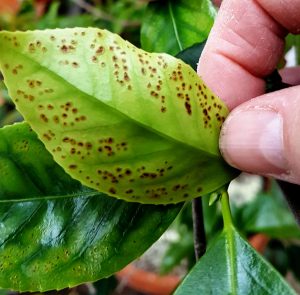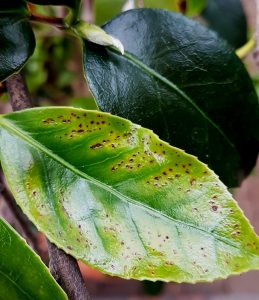(Question)


Hello again,
Also on the Camellia leaves, this time the newly emerging ones, are leaf spots. Note image 1 of 2 of the top and bottom of the leaves. Looks like fungus. Your thoughts would be greatly appreciated.These are a different problem than the first email with the browning patches of leaves which fall off.
(Answer)
It is challenging to determine what is causing the spots on your plant. There are a few possibilities:
- Overwatering or high humidity can cause oedema (edema), and camellias are commonly afflicted. The plant’s water balance is disrupted, with the roots absorbing more water than the leaves can get rid of. Excess water causes cells to rupture, leading to spots on the leaves that become raised and look like warts or pimples. They may rupture and look white/powdery, or can become rust in colour and look like scaly patches. If this is what has happened, don’t pick off the afflicted leaves. Instead, make sure the plant has good air circulation around it, and that the soil is draining well.
- Scab usually starts out as a tiny raised area on the leaf’s underside, but can also appear on the top of the leaf. The spots get bigger and can look corky and brown, and generally are irregular in size and shape. It is not caused by a pest, but rather is associated with moisture fluctuation or excessive moisture and is treated by improving drainage and growing conditions. However, your leaf also looks quite a bit lighter in colour than the healthy leaf that appears behind it in the photo. Scab should not alter the colour of the leaf. So scab is probably not the culprit.
- Tea scale is an insect that feeds on and infests the undersides of camellia leaves. The leaf usually looks fuzzy white – almost like powdery mildew, with the insects found underneath. However, your photos do not show this, so I don’t believe this is tea scale, although the “spots” look quite similar to those made by these insects. Tea scale does result in blotchy yellow upper surfaces in leaves. I’m mentioning this as these insects suck out the plant juices and can kill a plant. The remedy is to remove all afflicted leaves (put them in the garbage, don’t compost them) and spray the entire plant – including tops and bottoms of all leaves – with neem oil or horticultural oil – this smothers the critters. Repeat again a few months.
Here is a helpful resource:
- Clemson Cooperative Extension. Home & Garden Information Center. Camellia diseases & insect pests. [note: we don’t recommend use of fungicides or insecticides, which are referred to in this article; rather, we suggest controlling pests using cultural controls, and less toxic alternatives. In any event, Ontario’s cosmetic pesticides laws are quite strict and few such agents are available.]
I suggest that you take a couple of leaves to your closest nursery, to see if one of their experts can identify the problem(s) and recommend strategies on how to treat the plant. Please write us to tell us how your camellia fares!

